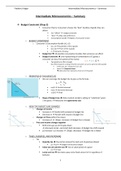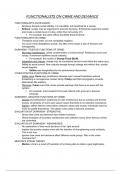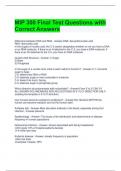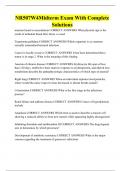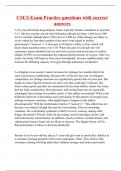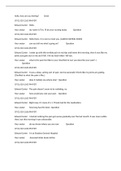Frédéric Kröger Intermediate Microeconomics – Summary
Intermediate Microeconomics – Summary
❖ Budget Constraint (Chap 2)
▪ Consumer theory: Consumers choose the “best” bundles of goods they can
afford
• Can “afford” → budget constraint
• “best” → utility and preferences
• Consumption bundle → Objects of consumer choice
o BUDGET CONSTRAINT
o Consumer’s Consumption Bundle (x1, x2)
• (x1, x2) → Quantities of the 2 goods
• (p1, p2) → Prices of the 2 goods
• m → Amount of money
▪ Budget Set ➔ All possible consumption bundles that someone can afford
▪ Budget Constraint ➔ Line representing all combinations of 2 goods a
consumer can buy if he spends all his money
• Two goods are often enough
(Can think of good 2 as being $ that the consumer can use to spend on other goods)
▪ In this case, p2 = 1$ (price of 1$ is 1$)
▪ Good 2 → Composite Good
➔ Abstraction that represents al but one of the goods
o PROPERTIES OF THE BUDGET SET
▪ We can rearrange the budget line to give us the formula :
• m/p2 → Vertical intercept
• m/p1 → Horizontal intercept
• -p1/p2 → Slope
▪ Slope of Budget Line ➔ Rate at which market is willing to “substitute” good
1 for good 2 → Measures the opportunity cost
o HOW THE BUDGET LINE CHANGES
o Changes in Income
▪ Increase m → Parallel shift outward of budget line
▪ Decrease m → Parallel shift inward of budget line
o Changes in Prices (affect the slope)
▪ Increase p1 → │Slope│ increases → Budget line is steeper
o Price and Income changes together
▪ Both prices go up and m goes down
→ intercepts (m/p1, and m/p2) both decrease → Budget line shifts inward
▪ p2 increase > p1 increase → │Slope│ decreases → Budget line is flatter
o TAXES, SUBSIDIES, AND RATIONING
o Tax
▪ Quantity tax ➔ Pay certain amount for each unit of good purchased
• p1 → p1+t → Budget line becomes steeper
▪ Value tax (ad valorem tax) ➔ Tax on value (price) of a good
• p1 → (1+τ)p1
▪ Lump sum tax ➔ Gov takes away some fixed amount of m regardless of
behavior
1
,Frédéric Kröger Intermediate Microeconomics – Summary
• Budget line shifts inward
o Subsidy ➔ Opposite of tax
▪ Quantity subsidy ➔ Give amount depending on amounts purchased
• p1 → p1-s → Budget line is flatter
▪ Ad valorem subsidy ➔ Subsidy based on price of good
▪ Lump sum subsidy ➔ Give amount regardless of behavior
• Budget line shifts outward
o Rationing constraints ➔ Consumption fixed to be no larger than some amount
o Sometimes taxes, subsidies, and rationing are combined
o BUDGET LINE CHANGES
o Perfectly balanced inflation → Doesn’t change anybody’s budget set and cannot
change anybody’s optimal choice
2
, Frédéric Kröger Intermediate Microeconomics – Summary
❖ Preferences (Chap 3)
o CONSUMER PREFERENCES
▪ Preferences have to do with entire bundle of goods not individual goods
▪ Can rank the bundles as to their desirability (preferences)
o Types of preferences
▪ Strictly Preferred ➔ (x1, x2) > (y1, y2)
▪ Indifferent ➔ (x1, x2) ̴(y1, y2)
▪ Weakly Preferred ➔ (x1, x2) ≥ (y1, y2)
o These relations are not independent concepts: are themselves related
▪ If (x1, x2) ≥ (y1, y2) and (y1, y2) ≥ (x1, x2) → (x1, x2) ̴(y1, y2)
▪ If (x1, x2) ≥ (y1, y2) and not indifferent → (x1, x2) > (y1, y2)
o ASSUMPTIONS ABOUT PREFERENCES
o 3 fundamental assumptions (axioms):
▪ Complete
• Any 2 bundles can be compared
▪ Reflexive
• Any bundle is at least as good as itself
▪ Transitive
• If (x1, x2) ≥ (y1, y2) and (y1, y2) ≥ (z1, z2) → (x1, x2) ≥ (z1, z2)
o INDIFFERENCE CURVES
o Indifference Curve ➔ Connects points representing different bundles btw which the
consumer is indifferent → Same level of utility
▪ 2 curves representing distinct levels of preference cannot cross
o Indifference Map ➔ Multiple indifference curves showing different levels of utility
o Weakly Preferred Set ➔ Area of all bundles that are at least as good as the bundle
o EXAMPLES OF PREFERENCES
o Perfect Substitutes
▪ Consumer is willing to substitute one good for another at constant rate
Ex. Only care about number of pencils not their colour
▪ Indifference curve → Constant Slope
▪ Utility function → U(x1, x2) = x1 + x2
o Perfect Complements
▪ Goods are always consumed together in fixed proportions
Ex. Right shoes and left shoes, 2 teaspoons of sugar per cup of tea
▪ Prefers to consume in fixed proportion (proportion not always one-to-one)
▪ Indifference curve → L shaped
o Bads
▪ Commodity that the consumer doesn’t like
Ex. Loves pepperoni but dislikes anchovies
▪ Indifference curve → Sloping up and to the right
o Neutrals
▪ Goods consumer doesn’t care about in one way or another
Ex. Loves pepperoni but neutral about anchovies
▪ Indifference curve → Vertical line
3
Intermediate Microeconomics – Summary
❖ Budget Constraint (Chap 2)
▪ Consumer theory: Consumers choose the “best” bundles of goods they can
afford
• Can “afford” → budget constraint
• “best” → utility and preferences
• Consumption bundle → Objects of consumer choice
o BUDGET CONSTRAINT
o Consumer’s Consumption Bundle (x1, x2)
• (x1, x2) → Quantities of the 2 goods
• (p1, p2) → Prices of the 2 goods
• m → Amount of money
▪ Budget Set ➔ All possible consumption bundles that someone can afford
▪ Budget Constraint ➔ Line representing all combinations of 2 goods a
consumer can buy if he spends all his money
• Two goods are often enough
(Can think of good 2 as being $ that the consumer can use to spend on other goods)
▪ In this case, p2 = 1$ (price of 1$ is 1$)
▪ Good 2 → Composite Good
➔ Abstraction that represents al but one of the goods
o PROPERTIES OF THE BUDGET SET
▪ We can rearrange the budget line to give us the formula :
• m/p2 → Vertical intercept
• m/p1 → Horizontal intercept
• -p1/p2 → Slope
▪ Slope of Budget Line ➔ Rate at which market is willing to “substitute” good
1 for good 2 → Measures the opportunity cost
o HOW THE BUDGET LINE CHANGES
o Changes in Income
▪ Increase m → Parallel shift outward of budget line
▪ Decrease m → Parallel shift inward of budget line
o Changes in Prices (affect the slope)
▪ Increase p1 → │Slope│ increases → Budget line is steeper
o Price and Income changes together
▪ Both prices go up and m goes down
→ intercepts (m/p1, and m/p2) both decrease → Budget line shifts inward
▪ p2 increase > p1 increase → │Slope│ decreases → Budget line is flatter
o TAXES, SUBSIDIES, AND RATIONING
o Tax
▪ Quantity tax ➔ Pay certain amount for each unit of good purchased
• p1 → p1+t → Budget line becomes steeper
▪ Value tax (ad valorem tax) ➔ Tax on value (price) of a good
• p1 → (1+τ)p1
▪ Lump sum tax ➔ Gov takes away some fixed amount of m regardless of
behavior
1
,Frédéric Kröger Intermediate Microeconomics – Summary
• Budget line shifts inward
o Subsidy ➔ Opposite of tax
▪ Quantity subsidy ➔ Give amount depending on amounts purchased
• p1 → p1-s → Budget line is flatter
▪ Ad valorem subsidy ➔ Subsidy based on price of good
▪ Lump sum subsidy ➔ Give amount regardless of behavior
• Budget line shifts outward
o Rationing constraints ➔ Consumption fixed to be no larger than some amount
o Sometimes taxes, subsidies, and rationing are combined
o BUDGET LINE CHANGES
o Perfectly balanced inflation → Doesn’t change anybody’s budget set and cannot
change anybody’s optimal choice
2
, Frédéric Kröger Intermediate Microeconomics – Summary
❖ Preferences (Chap 3)
o CONSUMER PREFERENCES
▪ Preferences have to do with entire bundle of goods not individual goods
▪ Can rank the bundles as to their desirability (preferences)
o Types of preferences
▪ Strictly Preferred ➔ (x1, x2) > (y1, y2)
▪ Indifferent ➔ (x1, x2) ̴(y1, y2)
▪ Weakly Preferred ➔ (x1, x2) ≥ (y1, y2)
o These relations are not independent concepts: are themselves related
▪ If (x1, x2) ≥ (y1, y2) and (y1, y2) ≥ (x1, x2) → (x1, x2) ̴(y1, y2)
▪ If (x1, x2) ≥ (y1, y2) and not indifferent → (x1, x2) > (y1, y2)
o ASSUMPTIONS ABOUT PREFERENCES
o 3 fundamental assumptions (axioms):
▪ Complete
• Any 2 bundles can be compared
▪ Reflexive
• Any bundle is at least as good as itself
▪ Transitive
• If (x1, x2) ≥ (y1, y2) and (y1, y2) ≥ (z1, z2) → (x1, x2) ≥ (z1, z2)
o INDIFFERENCE CURVES
o Indifference Curve ➔ Connects points representing different bundles btw which the
consumer is indifferent → Same level of utility
▪ 2 curves representing distinct levels of preference cannot cross
o Indifference Map ➔ Multiple indifference curves showing different levels of utility
o Weakly Preferred Set ➔ Area of all bundles that are at least as good as the bundle
o EXAMPLES OF PREFERENCES
o Perfect Substitutes
▪ Consumer is willing to substitute one good for another at constant rate
Ex. Only care about number of pencils not their colour
▪ Indifference curve → Constant Slope
▪ Utility function → U(x1, x2) = x1 + x2
o Perfect Complements
▪ Goods are always consumed together in fixed proportions
Ex. Right shoes and left shoes, 2 teaspoons of sugar per cup of tea
▪ Prefers to consume in fixed proportion (proportion not always one-to-one)
▪ Indifference curve → L shaped
o Bads
▪ Commodity that the consumer doesn’t like
Ex. Loves pepperoni but dislikes anchovies
▪ Indifference curve → Sloping up and to the right
o Neutrals
▪ Goods consumer doesn’t care about in one way or another
Ex. Loves pepperoni but neutral about anchovies
▪ Indifference curve → Vertical line
3

